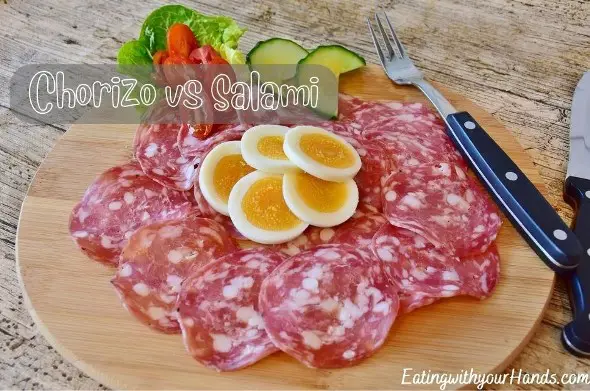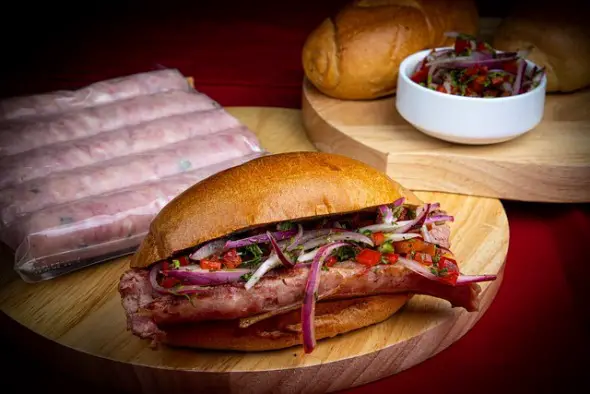When it comes to sausages, salami and chorizo are two of the most popular types that come to mind. Both are delicious and versatile in their own right, but what sets them apart?
In this article, we’ll take a closer look at the similarities and differences between chorizo and salami.

Table of Contents
Chorizo: The Iconic Pork Sausage
Chorizo, the beloved pork sausage, has captured the hearts and taste buds of people around the world since its inception in the picturesque Iberian Peninsula.
This mouthwatering meat snack comes in various delightful varieties, each country adding its unique twist through different preparation methods and spice blends.

Spanish and Portuguese Chorizo
Portuguese chouriço and Spanish chorizo stand out as the most authentic types of chorizo, characterized by pepper-based spice mixture and their curing process.
These sausages undergo a meticulous curing process, often drenched in red wine or vinegar, and seasoned with the unmistakable smoked paprika.
The taste can range from mildly smoky to incredibly hot, depending on the level of spiciness determined by the smoked paprika content.
Mexican Chorizo
Mexican chorizo, in contrast, is typically sold fresh and requires additional preparation before it can be savored. It’s made using fatty pork, with the meat ground (minced) instead of diced, giving it a unique texture.
While pork is the primary meat used, variations of Mexican chorizo can also include turkey, beef, or ham.
The seasoning is predominantly influenced by chili peppers. This choice is partly rooted in culinary traditions and partly driven by the expense linked to imported Spanish paprika.
American Chorizo
In the United States, when people use the term “chorizo,” they’re often talking about a sausage that has more fat, is not dried, and packs a noticeable spicy punch.
It has found popularity in regions near Mexico, as well as areas farther north, such as Texas, New Mexico, Austin, and Santa Fe.
It’s worth noting that in this region, the earliest records of chorizo can be traced back to the Wild West era.
Uses for Chorizo
Chorizo is an incredibly versatile ingredient that plays a starring role in a wide array of customary dishes, be it a festive celebration or an intimate gathering with loved ones.
Furthermore, it has gained popularity as a chic and convenient option for snacking or as an appetizer at trendy events.
In Spanish cuisine, chorizo takes center stage in various ways. It is commonly served with crusty bread and a glass of wine, making for a perfect appetizer or tapas.
It also lends its robust flavor to hearty stews and soups, infusing them with a rich, smoky essence that is truly irresistible.
Mexican cuisine embraces chorizo with open arms. Here, it is a beloved component in an assortment of dishes, including tacos, burritos, and breakfast classics like chorizo and eggs.
Salami: Understanding This Cured Meat

Salami, a cherished cured meat, comes in two primary varieties: air-dried or fermented. Traditionally crafted from pork, modern variations now incorporate various meats like beef, venison, lamb, duck, and, in certain regions, even horse or donkey.
What’s intriguing is that salami can also be a blend of different meat types, leading to a delightful array of unique and enticing flavors.
The Original Salami
The legend of salami traces back to Italy, dating to the era of ancient Rome. Its nomenclature derives from the Latin word “salare,” signifying “to salt” or “to sell.”
This etymological connection underscores the historical significance of salt in preserving meat, a practice that forms the backbone of salami production.
While Italy lays claim to the birthplace of salami, several European countries, including Germany, France, Spain, and Hungary, dispute this assertion.
The controversies about the origins of salami are as varied as the flavors of this cured meat. Nevertheless, salami is historically recognized and celebrated as the original from the Apennine Peninsula.
Types of Salami
The global adoration for salami has resulted in a remarkable array of shapes, sizes, and flavors.
Italy alone boasts an astounding 150 distinct types of salami, each with its unique characteristics and regional variations.
Traditional salami is primarily crafted from either pork or beef, characterized by its marbled appearance. For kosher and halal variations, beef is used, avoiding pork due to religious restrictions.
Yet, the versatility of salami extends to the use of other meats, such as turkey or venison.
In Northern Italy, goose salami has emerged as a sought-after culinary delight, showcasing the adaptability of this delectable delicacy.
Salami Ingredients
Salami is a masterpiece that seamlessly melds science and flavor. Its hallmark features include low water activity and an array of meticulously chosen ingredients, including colorings, preservatives, acidifying cultures, flavorings, and vitamins.
These components work in harmony to achieve not only an exquisite taste but also a prolonged shelf life.
The choice of ingredients imparts a broad spectrum of flavors, resulting in a kaleidoscope of salami experiences. Some variations lean towards spiciness, while others offer a milder, more nuanced profile.
Salami vs Chorizo: How Are They Similar?
The Preparation Process
Both salami and chorizo are made from cured meat and stuffed into animal intestine casings.
The meat is typically a combination of pork and beef, although different variations may include other meats such as lamb, venison, and even horse or donkey.
The meat is cured using a blend of spices, which can vary depending on the region and the recipe. However, some of the most common spices include garlic, paprika, salt, and vinegar.
After curing, the meat is ground and then stuffed into casings, where it is left to ferment and air-dry.
Nutritional Value
Both chorizo and salami are rich in vitamins and minerals, although they are also high in fat and salt. They are not typically considered healthy food, but they can be part of a balanced diet in moderation.
Additionally, they are an excellent source of protein and work well with low glycemic index diets due to their low sugar content.
>>Read more: does salami have black spots?
Chorizo vs Salami: What is The Difference?
Here are some key differences:
Spices and Flavor
The spices and flavor profile are the major difference between chorizo and salami. Chorizo is typically known for its spiciness and smokiness, while salami has a milder taste.
Spanish chorizo gets its distinct flavor from pimentón, which is a type of Spanish smoked paprika. The use of this spice gives the sausage a smoky, slightly sweet taste with a bit of heat. Depending on the variety of pimentón employed, chorizo can be either “dulce” (sweet) or “picante” (spicy).
In contrast, salami typically doesn’t have a smoky taste like pimentón, as it’s often seasoned with white pepper instead. The spices used in salami vary by region, but they usually include a mix of salt, pepper, and other herbs like fennel, garlic, or coriander. This gives the sausage a milder taste compared to chorizo.
Uses in Cooking
Chorizo and salami are both versatile ingredients in cooking, but they are often used in different ways.
Salami is a popular ingredient for sandwiches and as a topping for pizzas. It is also commonly served on cheese boards or as an appetizer alongside crackers and cheese.
Chorizo, on the other hand, is often used in heartier dishes. In Spain, it is frequently added to stews and soups, such as cocido or fabada asturiana.
In Latin American cuisine, chorizo is often used in rice dishes or mixed with beans for a flavorful and filling meal. It is also a popular addition to breakfast dishes, such as huevos con chorizo or chorizo breakfast burritos.
In addition to these traditional uses, both chorizo and salami can be used to add flavor to a variety of dishes.
Chorizo can be crumbled and added to pasta sauces or mixed into meatloaf or meatballs. Salami can be chopped and added to omelets or quiches, or used to add a savory note to salads.
Both sausages can also be used as a pizza topping, although the flavors of the two sausages are quite different, so they will give a distinct taste to the pizza.
Nutritional Values
Chorizo is generally lower in cholesterol, sodium, and sugar compared to salami. However, it is higher in saturated fat. One serving of chorizo (about 100 grams) typically contains 455 calories, 37 grams of fat, 19 grams of protein, 2.6 grams of carbohydrates, 88 milligrams of cholesterol, and 1,940 milligrams of sodium.
Salami, on the other hand, is lower in saturated fat but higher in cholesterol, sugars, and sodium compared to chorizo. One serving of salami (about 100 grams) contains 336 calories, 25 grams of fat, 25 grams of protein, 2.4 grams of carbohydrates, 100 milligrams of cholesterol, and 1,875 milligrams of sodium.
Both chorizo and salami are rich in minerals and vitamins, but they contain different amounts. Salami is high in vitamin K, while chorizo is a good source of vitamin D. Both sausages also contain iron, zinc, and vitamin B12.
It’s important to note that both chorizo and salami are high in fat, which makes them a less healthy food option if consumed in excess.
However, when consumed in moderation as part of a balanced diet, they can be enjoyed as a flavorful addition to meals or as a snack.
In Summary
While chorizo and salami share many similarities in terms of preparation and nutritional values, their distinct flavor profiles make them unique.
Chorizo is known for its spiciness, which comes from the use of Spanish smoked paprika, and is often used in dishes like scrambled eggs for breakfast or as a tapa in bars.
Salami, on the other hand, has a milder taste and is often used as a topping for sandwiches or pizza or served on a charcuterie board.
Ultimately, the choice between the two comes down to personal preference and the flavor profile that best suits the dish being prepared or enjoyed.
>>Read: How to Fix Dry Sausage.
Comparison
Chorizo salami, difference, difference, chorizo is made from pork shoulder, chorizo contains more fats than salami, chorizo is spicier than salami, salami or, vs salami, red meat, sausage types, typically made, curing salts, turkey salami, people.

Fernando is the creator and writer behind the food blog Eating with your Hands. Living and working in cities like Paris, Barcelona, and Berlin, and being married to a Canadian foodie, has given Fernando a passion and interest in food and inspired him to run EWYH.
